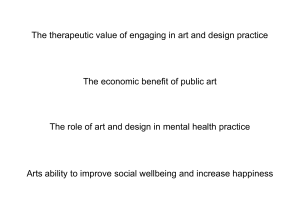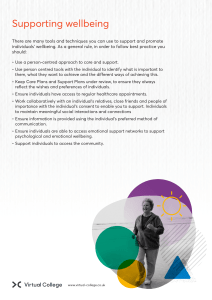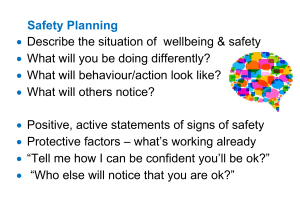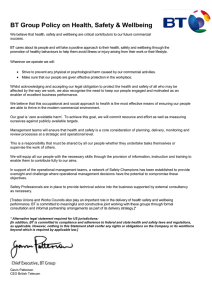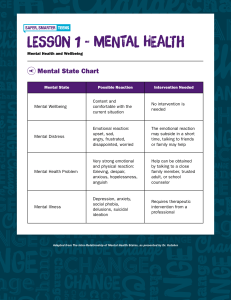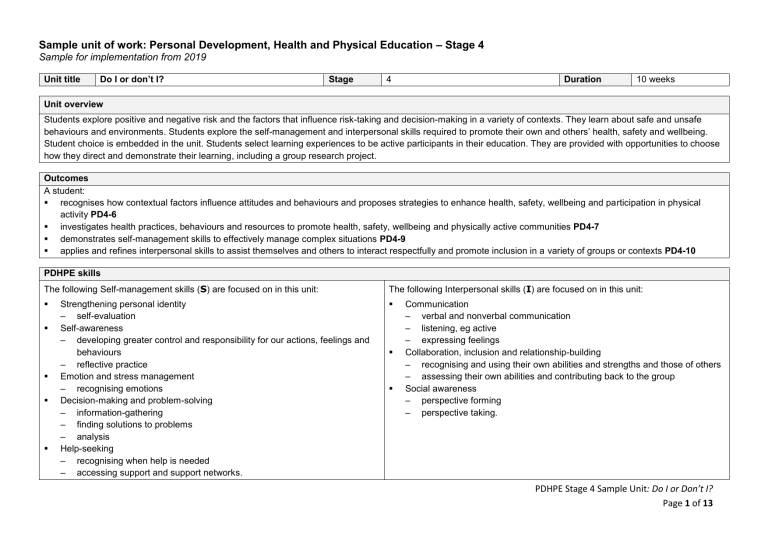
Sample unit of work: Personal Development, Health and Physical Education – Stage 4 Sample for implementation from 2019 Unit title Do I or don’t I? Stage 4 Duration 10 weeks Unit overview Students explore positive and negative risk and the factors that influence risk-taking and decision-making in a variety of contexts. They learn about safe and unsafe behaviours and environments. Students explore the self-management and interpersonal skills required to promote their own and others’ health, safety and wellbeing. Student choice is embedded in the unit. Students select learning experiences to be active participants in their education. They are provided with opportunities to choose how they direct and demonstrate their learning, including a group research project. Outcomes A student: recognises how contextual factors influence attitudes and behaviours and proposes strategies to enhance health, safety, wellbeing and participation in physical activity PD4-6 investigates health practices, behaviours and resources to promote health, safety, wellbeing and physically active communities PD4-7 demonstrates self-management skills to effectively manage complex situations PD4-9 applies and refines interpersonal skills to assist themselves and others to interact respectfully and promote inclusion in a variety of groups or contexts PD4-10 PDHPE skills The following Self-management skills (S) are focused on in this unit: The following Interpersonal skills (I) are focused on in this unit: Strengthening personal identity – self-evaluation Self-awareness – developing greater control and responsibility for our actions, feelings and behaviours – reflective practice Emotion and stress management – recognising emotions Decision-making and problem-solving – information-gathering – finding solutions to problems – analysis Help-seeking – recognising when help is needed – accessing support and support networks. Communication – verbal and nonverbal communication – listening, eg active – expressing feelings Collaboration, inclusion and relationship-building – recognising and using their own abilities and strengths and those of others – assessing their own abilities and contributing back to the group Social awareness – perspective forming – perspective taking. PDHPE Stage 4 Sample Unit: Do I or Don’t I? Page 1 of 13 Syllabus content Students: examine factors that influence health and wellbeing – investigate reasons why young people choose to engage in risk-taking behaviour, eg nominating for a leadership position, online communication – examine risk-taking scenarios and discuss the outcome of positive and negative risk behaviour on health and wellbeing, eg trying out for a sporting team, drinking alcohol at a party I Teaching, learning and assessment Registration Inquiry question: What positive actions contribute to the health, safety, wellbeing and participation in physical activity levels of the wider community? Learning intentions: discuss these with students and make them visible. They should focus on student knowledge, understanding and skills in relation to the outcome(s). For example: I know the contextual factors that can influence my attitude and behaviours and how this can be both positive and negative and that it’s important to examine the outcomes before engaging in risk-taking behaviour (knowledge). I understand the reasons why young people choose to engage in risk-taking and the possible outcomes (understanding). I can recognise the possible outcomes of risk-taking scenarios and stop and think of the skills I need to enact in order to make positive decisions (skills). Understanding risk Introduce the concept of ‘risk’ by asking students the following questions: What is risk? Do you enjoy taking risks? Students may respond verbally, with a show of hands, or using ICT polling tools such as Poll Everywhere, Socrative or Mentimeter. Chart the responses to prompt further class discussion, for example: What is the difference between a risk and a danger? Are risks positive or negative? Reasons for risk-taking – PMI chart In small groups, students brainstorm the reasons why young people choose to engage in risk-taking behaviour. They complete a PMI chart to classify each reason as either positive or negative, in terms of the effect it can have on health and wellbeing. If groups do not reach a consensus, they classify the reason as interesting. Groups share their responses with the class. Sample reasons may include: Seeking independence from parents/carers trying new things out for themselves peer pressure trying to stand out from the crowd peer acceptance establishing an identity sense that harm will not happen to them thinking that potential harm is too far in the future to consider (eg smoking) PDHPE Stage 4 Sample Unit: Do I or Don’t I? Page 2 of 13 Syllabus content Teaching, learning and assessment an opportunity to make new friends an opportunity to learn new things about themselves an opportunity to improve their leadership skills instant gratification outweighs the risk. Classifying degree of risk In pairs, students view pictures of young people participating in different activities. Provide pictures to illustrate the following risk-taking activities/scenarios: online communication nominating for a leadership position passenger without a seatbelt parkour riding a bicycle without a helmet gambling on a sporting match starting a relationship sunbaking smoking a cigarette walking home alone after dark drinking alcohol at a party meeting someone from an internet chat dangerous driving trying out for a sporting team volunteering in the community setting a fitness challenge, eg competing in a fun run. Registration For each picture, students: rank the activity/behaviour from ‘least’ to ‘most’ risky classify the activity/behaviour as either a positive risk or a negative risk discuss whether they would participate in the activity/behaviour, providing a reason for their choice. Students view a video about risk-taking, for example: YouTube – Jeb Corliss ‘Harnessing Fear’ TED talk YouTube – Hillary Clinton discusses the benefits of taking risks YouTube – Teens taking risks – inside your brain PDHPE Stage 4 Sample Unit: Do I or Don’t I? Page 3 of 13 Syllabus content Teaching, learning and assessment YouTube - Joel Thompson shares his story for Yarn safe Registration Making connections: Visible Thinking routine Students explore concepts raised in their chosen video by completing the 4Cs Visible Thinking routine: 1. Connections – What connections do you draw between the video and your own life and learning? 2. Challenge – What ideas, positions or assumptions from the video do you want to challenge or argue? 3. Concepts – What key concepts or ideas do you think are important or worth holding onto from the video? 4. Changes – What changes in attitudes, thinking or action are suggested by the video, either for you or others? Students choose three scenarios from the above list of risk-taking activities/scenarios. Using a graphic organiser, they outline the positive and/or negative effect of each scenario on the health and wellbeing of young people. Students share responses with the class. Assessment as and assessment of learning Students consider the interpersonal skills required to help navigate each scenario. They review and refine their initial definition of risk. Students choose one of the following quotes and compose a persuasive text to argue the benefits of positive risk-taking to the health and wellbeing of young people. ‘To know what life is worth you have to risk it once in a while’ Jean-Paul Sartre ‘It (life) is constantly changing, and yet it remains the same’ Jan Hawkins ‘The biggest risk is not taking any risk’ Mark Zuckerberg ‘The only person who never makes mistakes is the person who never does anything’ Unknown ‘Don’t be afraid to go out on a limb. That’s where the fruit is’ Unknown. Students: propose and develop protective strategies to effectively manage their own personal health, safety and wellbeing (ACPPS073) – – recognise the importance of trusting their own feelings, thoughts and reading of different situations S analyse how emotions, strengths and decisionmaking can affect Inquiry question: How can I effectively manage my own and support others’ health, safety, wellbeing and participation in physical activity? Learning intentions: discuss these with students and make them visible. They should focus on student knowledge, understanding and skills in relation to the outcome(s). Protective strategies: summation Students read the Forbes article, ‘4 strange ways your emotions influence the risks you take’. They summarise the article by completing the following sentences: 1. This article is mostly about … 2. The important parts are … 3. The key lesson is … PDHPE Stage 4 Sample Unit: Do I or Don’t I? Page 4 of 13 Syllabus content outcomes in different scenarios S – examine and develop strategies for safe practices in outdoor environments, eg farm safety, exposure to sun, water environments Teaching, learning and assessment Think, pair, share Students choose one risk-based activity/scenario from the activity ‘Classifying degrees of risk’ and complete the following: Think – individually, students brainstorm how feelings and thoughts can influence risk-taking. Pair – students then share and discuss their responses with a partner to decide on the three most important ways feelings and thoughts can influence risk-taking. Pairs choose one decision-making model/process and apply it to their activity/scenario/situation. They consider how emotions and strengths can affect the outcome. For example: Stop, Think, Do 7 steps to effective decision-making Share – each pair shares with the class how they worked through their activity/scenario/situation based on a decision-making model and justify the decision they came to. Students choose how they share their decision-making model with the class, eg discussion, charades/improvisation/role-play or a presentation using ICT tools. Registration Reflection In response to the presentations, students reflect on the benefits of working through the decision-making process to manage their own personal health, safety and wellbeing. They summarise their reflections by completing the following framed paragraph: One key idea was … this is important because … Another key idea … this matters because … Strategies for safe practices: inquiry learning Students choose one of the following outdoor environments: road, farm, sun or water. They examine strategies that reduce risk. Refer to Appendix 1. Students propose additional strategies for safe practices for young people in their chosen outdoor environment. For example: road-user behaviour – NSW Centre for Road Safety: staying safe , Indigenous road safety video – Being Safe, not sorry farm safety – Farmsafe exposure to sun – Cancer Council: sun protection recommendations water environments – Water safety: a NSW government initiative , Indigenous Aquatic Safety Training Students share their proposed strategies with the class. PDHPE Stage 4 Sample Unit: Do I or Don’t I? Page 5 of 13 Syllabus content Teaching, learning and assessment Assessment of learning Three facts they learnt about emotions, risk and decision-making. Two positive actions to counter potentially unsafe risk-taking activities, situations or behaviour. One thing they will do differently as a result of this lesson. Students: Inquiry question: What positive actions contribute to the health, safety, wellbeing and participation in physical activity levels of the wider community? recognise potentially unsafe environments and describe strategies to promote their own and others’ health, safety and wellbeing in a variety of real-life situations: – examine strategies and develop plans to keep themselves and others safe in the following real-life scenarios: at a party, chatting or sharing information online, travelling alone, getting in a car with a drunk driver, swimming at night, experiencing unwanted sexual behaviour, feeling depressed S Registration Learning intentions: discuss these with students and make them visible. They should focus on student knowledge, understanding and skills in relation to the outcome(s). Elevator pitch Students recall the decision-making models and safety strategies/plans from previous lessons. They choose one real-life scenario and develop an elevator pitch (strategy and plan) that reduces risk and keeps themselves and others safe. The video 6 elevator pitches for the 21st century will help students understand the importance of being able to speak succinctly and use strategies to engage their audience in different contents. The elevator pitch should outline in 60 seconds or less: 1. Why is the idea beneficial? Justify why any alternative solution is not recommended. 2. Who is the target audience? 3. What is the new idea? 4. How is the idea unique? Scenarios include: at a party, chatting or sharing information online, travelling alone, getting in a car with a drunk driver, swimming at night, experiencing unwanted sexual behaviour, feeling depressed. (Teacher note: Remind students of the sensitive nature of some of these scenarios. Ensure students have strategies to manage disclosure relating to any of these sensitive issues.) Students present their elevator pitch to the class. (Teacher consideration: ensure a variety of scenarios are covered by the class.) Assessment of learning ‘What’ they learned. ‘So what?’ (why is it important and what are the implications). ‘Now what?’ (how to apply it or do things differently). PDHPE Stage 4 Sample Unit: Do I or Don’t I? Page 6 of 13 Syllabus content Students: recognise potentially unsafe environments and describe strategies to promote their own and others’ health, safety and wellbeing in a variety of real-life situations: – classify drugs and describe the short-term and longterm effects of drug use on health, safety and wellbeing I examine influences on peoples’ behaviours, decisions and actions (ACPPS074) – discuss the influence of contextual factors on individual decisions and actions, eg response to emerging world issues, sexual relationships, drug use, preventive sexual health practices I explore the relationship between various health, safety and physical activity issues affecting young people and assess the impact it has on the health, safety and wellbeing of the community assess the impact of drug use on young people’s decisions and behaviours Teaching, learning and assessment Registration Inquiry question: What positive actions contribute to the health, safety, wellbeing and participation in physical activity levels of the wider community? Learning intentions: discuss these with students and make them visible. They should focus on student knowledge, understanding and skills in relation to the outcome(s). Potentially unsafe environments The teacher displays an image of a legal drug product without any explanation, for example alcohol. In pairs, students interpret the image and consider: What is the drug? Why is the drug used? Is it risky to use this drug? Students share their responses with the class. In pairs or small groups, students list scenarios/situations when drug use is a positive risk and a negative risk. Scenarios/situations may include: Drug use – positive risk (+) Drug use – negative risk (-) Diabetic medication Binge drinking at a party Antibiotics for a virus Using illegal drugs Painkillers for a sports injury Getting in a car with a drunk driver Antihistamines for allergic reactions Misusing over the counter (OTC) drugs Justification Students share their list with the class. Referring to their list of examples, students justify why they consider drug use to be a positive and/or negative risk. Research project In small groups, students work collaboratively on a research project to answer the following driving question: ’How does drug use affect health, safety and wellbeing?’ As part of the research process, students respond to the following direct questions to guide their research: 1. How are drugs classified? 2. What are the short-term and long-term effects of drug use? Provide examples. 3. What is the impact of drug use on young people’s decisions and behaviours? Provide examples. 4. What is the influence of contextual factors (see syllabus glossary) on individual decisions and actions relating to drug use? PDHPE Stage 4 Sample Unit: Do I or Don’t I? Page 7 of 13 Syllabus content in various contexts and predict how this might affect the future health, safety and wellbeing of individuals and the community, eg sexual decisions, road-user behaviours S Teaching, learning and assessment 5. Analyse how drug use might affect the future health, safety and wellbeing of individuals and the community. Registration Groups use a KWHL chart to gather information, document their learning process and respond to the driving question. At conclusion of the research process, students present their research findings and learnings to an audience. Refer to Appendix 2 for KWHL research process and instructions. Assessment of learning Students reflect on the research process, considering: Contributions they made to the group and project success. Obstacles to success during the research process. How did they solve these? What they will do differently when working on their next project and why. PDHPE Stage 4 Sample Unit: Do I or Don’t I? Page 8 of 13 Assessment for, as and of learning Assessment for, assessment as and assessment of learning are approaches that enable teachers to gather evidence and make judgements about student achievement. These are not necessarily discrete approaches and may be used individually or together and formally or informally. Some examples of assessment FOR learning in this unit include: Clear learning goals or intentions for the learning activities. Self-assessment and peer-assessment, eg reflection, scenarios and role-plays, video feedback. Some examples of assessment AS learning in this unit include: Inquiry-based learning that encourages students to take responsibility for their own learning, eg researching health services and strategies for safe practices. Students using peer feedback to refine their work, eg scenarios and role-plays, elevator pitch, visible thinking routine. Some examples of assessment OF learning in this unit include: Questioning/discussion strategies to assess students’ knowledge and understanding to plan for future learning, eg Gallery walk, physical barometer, pinwheel discussion, affinity mapping, visual mapping, concentric circles, conver-stations, fishbowl, snowball discussions, talk moves, think-pair-share, mini whiteboards, online quizzes. Observation of students’ knowledge, understanding and skills through their work and participation in activities, eg persuasive text. Exit cards/slips. Research project. In small groups, students complete a research project to answer the following driving question: ‘How does drug use affect health, safety and wellbeing?’ Unit evaluation – please tick (✓) Unsatisfactory Satisfactory Good Excellent Not applicable ………………………………. Date: …………. Comments/suggestions for improvement The unit adequately addresses syllabus outcomes. The unit reflects the needs, interests and abilities of students. The unit provides opportunity for students to demonstrate what they know and can do. The unit includes a variety of teaching and learning activities, and resources to address the learning needs of all students. Teacher Name: …………………………………………………. Signature: PDHPE Stage 4 Sample Unit: Do I or Don’t I? Page 9 of 13 Propositions Comment and suggest opportunities for improvement This unit has the following propositions embedded in teaching, learning and assessment: educative purpose strengths-based approach value movement health literacy critical inquiry approach. Resources Australian Government - Indigenous Road Safety - https://infrastructure.gov.au/roads/safety/indigenous_road_safety/index.aspx Cancer Council – sun protection recommendations: www.cancercouncil.com.au/cancer-prevention/sun-protection/be-sunsmart/ Elevator pitch: en.oxforddictionaries.com/definition/elevator_pitch Farmsafe: farmsafe.org.au/Children-On-Farms Four strange ways your emotions influence the risks you take: www.forbes.com/sites/amymorin/2016/06/04/4-strange-ways-your-emotions-influence-the-risks-you-take/#734af4ef3e8d Graphic organiser: www.iccb.org/iccb/wp-content/pdfs/adulted/tdl_bridge_curriculum/tdl_context_reading/tdl_reading_resource_file/Positive_Negative_Chart.pdf KWHL chart: olms.cte.jhu.edu/olms2/data/ck/sites/1943/files/KWHL Chart(1).pdf Mentimeter: www.mentimeter.com/ NSW Centre for Road Safety – staying safe: roadsafety.transport.nsw.gov.au/stayingsafe/index.html Persuasive text: www.readwritethink.org/files/resources/printouts/persuasion%20map.pdf PMI chart: www.globaleducation.edu.au/verve/_resources/pmi.pdf Poll everywhere: www.polleverywhere.com/ Royal Life Saving Australia: Indigenous Aquatic Safety Training - https://www.royallifesaving.com.au/programs/community-development/indigenous-programs Seven steps to effective decision-making: www.umassd.edu/media/umassdartmouth/fycm/decision_making_process.pdf 6 elevator pitches for the 21st century: www.youtube.com/watch?v=XvxtC60V6kc Socrative: www.socrative.com/ Stop, Think, Do: www.fulhmgdnps.sa.edu.au/docs/policies/stop_think_do.pdf The 4C’s Visible Thinking routine: www.academicenglishlearners.com/uploads/1/6/8/5/16850748/4croutine.docx.pdf YouTube – Jeb Corliss ‘Harnessing Fear’ TED talk: www.youtube.com/watch?v=oU7iz1Y36DU&t=248s YouTube – Hillary Clinton discusses the benefits of taking risks: www.youtube.com/watch?v=Qr2SLAPeYU4 YouTube – Teens taking risks – inside your brain: www.youtube.com/watch?v=phbAHP6T5c8 PDHPE Stage 4 Sample Unit: Do I or Don’t I? Page 10 of 13 YouTube - Joel Thompson shares his story for Yarn safe: https://headspace.org.au/yarn-safe/ Water safety – a NSW government initiative: www.watersafety.nsw.gov.au/ PDHPE Stage 4 Sample Unit: Do I or Don’t I? Page 11 of 13 APPENDIX 1 Examine strategies for safe practices in outdoor environments Choose one of the following outdoor environments: road, farm, sun or water. Using the template below: 1. Examine the strategies that reduce risk in this environment. 2. Propose additional strategies for safe practices for young people in their chosen outdoor environment. 3. Share your proposed strategies with the class. The following websites will assist your inquiry: Road-user behaviour: NSW Centre for Road Safety: staying safe Farm safety: Farmsafe Exposure to sun: Cancer Council: sun protection recommendations Water environments: Water safety: a NSW government initiative Outdoor environment selected: …………………………………………………………………………………………………… Interesting information Important information Insert information here Insert information here Big idea from each strategy Insert information here PDHPE Stage 4 Sample Unit: Do I or Don’t I? Page 12 of 13 APPENDIX 2 KWHL research process and instructions ‘How does drug use affect health, safety and wellbeing?’ K W What do we know? Students consider what they already know about drug use and health. For example: Explore prior knowledge, what can they recall? Share interesting facts and/or insights. Brainstorm words, terms or phrases they associate with drug use. Teacher consideration: students may suggest information that is not accurate. These statements should be turned into questions and added to the ‘W’ column. What do we wonder? Students direct their thinking towards the directed questions: How are drugs classified? What are the short-term and long-term effects of drug use? Provide examples. What is the impact of drug use on young people’s decisions and behaviours? Provide examples. How do contextual factors impact on individual decisions and actions relating to drug use? Predict how drug use might affect the future health, safety and wellbeing of individuals and the community. Students continue to add questions to this column during the research process. Teacher consideration: continual provision of feedback during this stage. Students document how they will learn more to answer the driving question. They determine which resources will best help them answer the driving question. Students evaluate sources and select the ones most appropriate for the research task. H L How do we find information? What we have learned? Teacher provides guidance and feedback during this stage. Suggested resources include: Positive Choices positivechoices.org.au/students/ Alcohol and Drug Foundation adf.org.au/drug-facts/ National Drug and Alcohol Research Centre ndarc.med.unsw.edu.au/resource-type/ fact-sheets Australian Government Department of Health www.health.gov.au/internet/publications/publishing.nsf/Content/drugtreat-pubs-front6wk-toc~drugtreat-pubs-front6-wk-secb~drugtreat-pubs-front6-wk-secb-3~drugtreatpubs-front6-wk-secb-3-1 National Drug Strategy Household Survey (NDSHS) 2016 www.aihw.gov.au/reports/illicit-use-of-drugs/ndshs-2016-key-findings/contents/ summary Groups conduct research. Students add information gathered to this column, recording their findings and what was learned. To make learning visible, groups present their research findings and learnings. This includes: Research findings Groups choose how they report on research findings to answer the driving question. For example, a poster, website, brochure, blog, infographic or news article. Presentation of learning Groups present what they learned to an audience (eg class, Year group, school) in the format of a mini trade show, conference or exhibition. This should include: The topic and content (research findings). Reflections about how they learn, how their group functioned, new content knowledge gained while working on the project. The biggest takeaway from the project. What is the most important thing learned? PDHPE Stage 4 Sample Unit: Do I or Don’t I? Page 13 of 13
